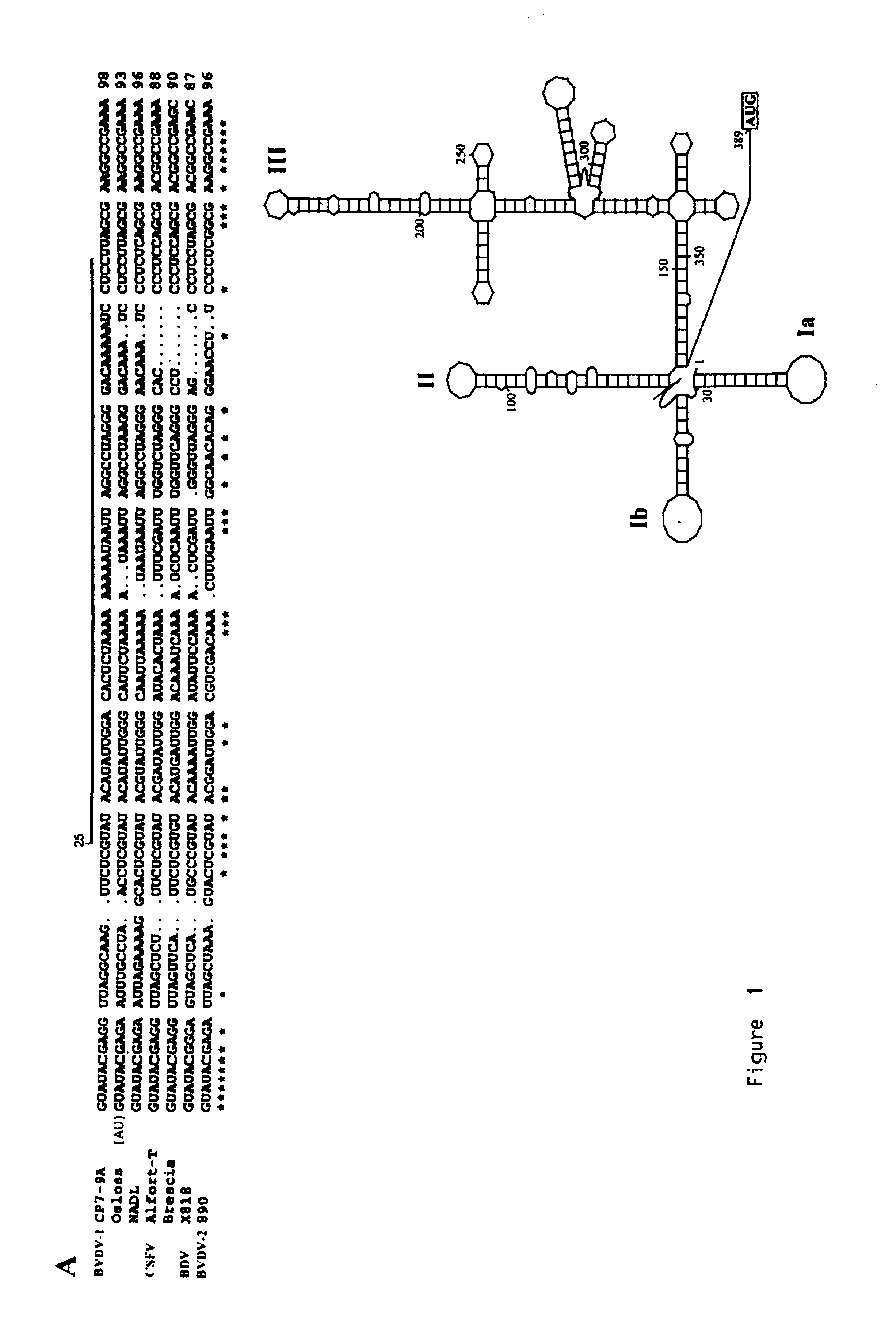Pestivirus mutants and vaccines containing the same
a technology of pestivirus and mutants, which is applied in the field of attenuated pestivirus mutants, can solve the problems of persistent infection in the offspring, fetal death, growth malformation,
- Summary
- Abstract
- Description
- Claims
- Application Information
AI Technical Summary
Problems solved by technology
Method used
Image
Examples
example 1
Generation of Infectious cDNA Clones of BVDV and Resulting CP7-5A Virus
(A) Generation of Infectious cDNA Clone of BVDV
[0036]After cDNA cloning of the genome of bovine viral diarrhea virus strain CP7, the full-length cDNA clone pA / BVDV was constructed (described in detail by Meyers et al., J. Virol. 70: 8606-8613). The 5′ terminal sequence of the CP7 genomic RNA comprising the 5′ proximal 21-23 nucleotides (nt) and the 3′ terminal 33 nt (when compared to published sequences of other BVDV strains) were not determined; instead the respective terminal sequences of the heterologous BVDV-1 strain NADL were introduced into pA / BVDV.
(B) Generation of the Infectious cDNA Clone pCP7-5A
[0037]In order to establish an authentic infectious cDNA clone of BVDV CP7, the 5′ and 3′ terminal sequence of this virus were determined. After ligation of the viral genomic RNA, a nested RT-PCR assay (using sense primers located at the 3′ end of the genome and antisense primers located in the 5′ NTR of the geno...
example 2
Materials and Methods for Generating the 5′ NTR Mutant Viruses
[0044]The first set of mutations within the 5′ terminal 30 nt of CP7-5A was designed to alter both the nucleotide sequence and predicted RNA secondary-structure of hairpin la at various positions. Hairpin la includes a stem which is formed by base-pairing of nt 1-10 of the CP7 genome to the complementary sequence of nt 21-30, while the remaining 10 nt (11-20) form an apical loop. The RNAs of mutants SL-1, SL-2, and SL-3 lack nucleotide(s) 2, 6-7, and 14-17, respectively. In addition, several mutants were constructed which contain nucleotide substitutions at positions 2-4 (SL-4), 5-7 (SL-5), 10-13 (SL-6), and 27-29 (SL-7). The RNAs of SL-8, SL-9, delta 2-31, delta 5-57, and delta 5-73 lack nucleotides 1-24, 2-29, 2-31, 5-57, and 5-73. The predicted RNA secondary structures of the (altered) hairpin la is shown in FIG. 5A. Construction of all CP7 full-length cDNA clones carrying mutations within the 5′ NTR was based on the g...
example 3
Description of the Properties of the Mutants
[0047]For comparative analyses of the properties of the BVDV 5′ NTR mutants, the transcription / transfection experiments using the whole set of mutants were performed in parallel and repeated several times. These analyses included determination of the specific infectivity of the respective genomic RNAs, IFA and determination of viral yields after transfection as well as determination of the average plaque size, growth rate and yield of the recovered mutant viruses.
[0048]After transfection of MDBK cells (as described above) with 2 μg of genomic RNA, one tenth of the transfected cells was used for a plaque assay in order to determine the specific infectivity of the RNA and the plaque sizes of the recovered viruses. 10-fold serial dilutions of transfected cells together with 2×106 untreated MDBK cells were seeded into six-well dishes. After incubation at 37° C. for 4 h, the attached cells were overlaid with semisolid medium containing 0.6% low...
PUM
| Property | Measurement | Unit |
|---|---|---|
| plaque size | aaaaa | aaaaa |
| size | aaaaa | aaaaa |
| size | aaaaa | aaaaa |
Abstract
Description
Claims
Application Information
 Login to View More
Login to View More - R&D
- Intellectual Property
- Life Sciences
- Materials
- Tech Scout
- Unparalleled Data Quality
- Higher Quality Content
- 60% Fewer Hallucinations
Browse by: Latest US Patents, China's latest patents, Technical Efficacy Thesaurus, Application Domain, Technology Topic, Popular Technical Reports.
© 2025 PatSnap. All rights reserved.Legal|Privacy policy|Modern Slavery Act Transparency Statement|Sitemap|About US| Contact US: help@patsnap.com



